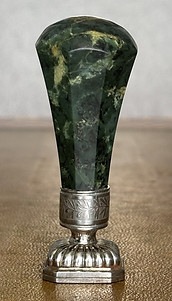The Green Collection
Wax Seal Stamps with Handles of Various Green Stones, including Malachite, Jade, and Jasper
This finely crafted wax seal stamp, made of malachite and silver, may have belonged to Marguerite de Vaugelas, who married Count Maxence Le Fèbvre. The engraved arms - Azure, a chevron Or between, in chief, two bunches of grapes, and in base a tower crowned, accompanied in chief by a sun - correspond to those of Marguerite’s family. By contrast, the arms of Maxence, which feature a pelican feeding its young, show discrepancies between the design on this seal and the versions recorded in heraldic references, which may reflect a personal adaptation.




Materials of Distinction: The Green Stones Behind Noble Wax Seal Stamps.
Among the most prized materials used in the crafting of wax seal stamp handles were green semi-precious stones such as jade, malachite, and serpentine, each selected not only for their natural beauty but also for their symbolic and cultural resonance. Jade, especially nephrite, was the most coveted of these, celebrated for its smooth texture, luminous depth, and associations with nobility, purity, and immortality. It was primarily sourced from China, Central Asia, and parts of Eastern Europe, and was often traded at great cost. Malachite, with its rich, banded green striations, was extracted from the Ural Mountains of Russia and became particularly popular in the 18th century when Russian artisans mastered the technique of turning and polishing it into ornamental objects. Serpentine, a darker and more understated stone, was mined in regions like Italy, Germany, and the British Isles, and lent itself well to the more austere tastes of early neoclassicism.
These green stone handles signaled refinement and wealth, especially when paired with gilt bronze or silver-gilt mounts. Their value varied depending on the quality of the stone and craftsmanship, but in general, such handles were significantly more expensive than those made of wood, ivory, or even silver. They were favored by aristocrats, diplomats, and courtly collectors who regarded them not merely as tools of correspondence but as objets d’art. In the world of wax seals, a green stone handle was both a mark of status and a subtle declaration of aesthetic taste.

This stamp is not a noble family's wax seal stamp but an episcopal stamp from the 19th century. It is made of green bloodstone with a silver base. Ecclesiastical heraldry follows specific conventions regarding the use of arms associated with the church’s administrative and collegiate bodies, as well as the depiction of clerical arms. Abbeys, priories, and dioceses each have their own heraldic symbols.



This stamp shows the alliance arms of Marquis Joseph de Lévézou de Vézins and Gabrielle Dor de Lastours. The de Lévézou de Vézins family descends from the barons of Lévézou, a powerful feudal house. They held the title of marquis, and several branches existed over time. Their influence extended across several regions of France, particularly through strategic marriages. Among the notable members of the family are Jean-Jacques de Lévézou de Vézins (1738–1821), Marquis de Vézins, who was an officer who survived the French Revolution and later participated in royalist circles during the Bourbon Restoration. Renaud de Vezins was both a painter and a politician, who died in an accident in his Bugatti. The Dor de Lastours family appears in the 16th century under the name Dor. It is at the beginning of the 18th century that the family adopted the name Dor de Lastours, following the acquisition of the castle of Lastours.





Renaud, Count de Lévézou de Vezins
(1882-1932)

Stamp of Josephde de Lévézou de Vézins and Gabrielle Dor de Lastours

Livery button with the alliance arms of Marquis De Lévézou de Vesins and Dor de Lastours.
This is a beautiful 19th-century Russian stamp with a Fabergé mark. It is one of my favorite auction acquisitions. I very much like the Siberian nephrite jade used for the handle, and the elephant design is really charming. Fabergé produced a number of wax seal stamps, though they were not as common as the jewelry and decorative objects. The House of Fabergé crafted high-quality seals, often using luxurious materials like gold, silver, nephrite jade, rock crystal, and precious gemstones.




An exception in my collection. I typically focus on antique European wax seal stamps engraved with noble family coats of arms. This one, however, features a monogram, which is something I don’t usually look for. But I was drawn to its antique "column" design, which I found interesting, so it earned a place in my "Green Collection."



This stamp that dates back to around 1850 belonged to Lord William Vane, the 3rd Duke of Cleveland who also succeeded to the 5th Earl of Durham. The Vane family had long-standing noble roots in County Durham and became Dukes of Cleveland in the 19th century. The ducal title of Cleveland had originally been created in the 17th century for Barbara Villiers, a mistress of Willam III, and was later revived for the Vane family in the 19th century. The seal is made of faceted bloodstone with a gold base. The coat of arms is finely carved in red stone. The engraving shows the alliance coat of arms of William Vane and his wife Lady Grace Lowther, who he married in 1815. Lady Grace was the youngest of the 6 children of William Lowther, the 1st Earl of Lonsdale. Few stamps in this collection feature the coronet of a British Duke, making this one a valuable addition. A British duke's coronet features "strawberry leaves," similar to French heraldry. However, in heraldic representation, it also includes a dark red cap, which is purple in real life, topped with a gold tassel. This cap is a distinct element not found in French heraldry. (Ai)



%2C%201st%20Earl%20of%20Lonsdale.jpg)




William Vane, 1st Duke of Cleveland (1766-1842), father of Lord William

Seal stamp engraved with the alliance coat of arms of
William Vane and Lady Grace Lowther

William Lowther, 1st Earl of Lonsdale (1757-1844), father of Lady Grace
A nice find and one of my favorites, probably because of the shape of its handle and the details of its base. This wax seal stamp is made of stone. I was initially skeptical about buying it online but was very pleased when it arrived. It stands out from the usual stamps in my collection. The family crest is well done, featuring a very finely carved Count’s crown, two stars, and a sun symbolizing glory and splendor. Though purchased in England, it is likely of French origin.



This small personal seal stamp belonged to my great-grandmother, Baroness Marthe de Mévius. A daughter of Baron Eugène de Mevius, she married my great grandfather, Count Étienne van der Straten Ponthoz. Although this seal is an exception within the collection, as it is not engraved with a coat of arms, it remains a highly precious and personal piece.





This stamp with a beautiful green stone handle originates from Germany. Often seen in the German heraldry, the shield is surmounted by three helmets. The presence of multiple helmets is a notable mark of prestige, reflecting complex lineage and significant inheritance. In this case, it indicates that the armiger belonged to a high-ranking noble family with at least three distinguished inherited lines or titles, each entitled to its own crest. The identity of the stamp’s original owner, however, remains to be discovered.



Gerry's Collection of Antique Seal Stamps.



